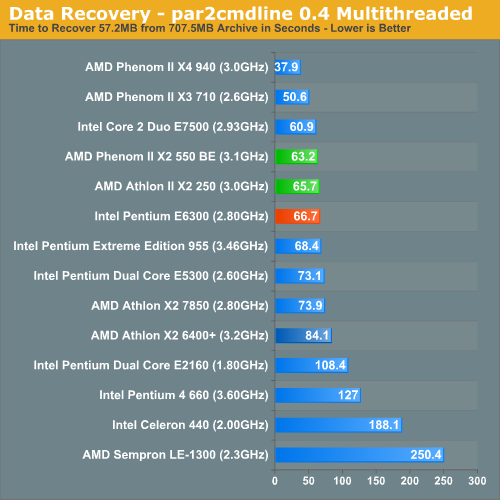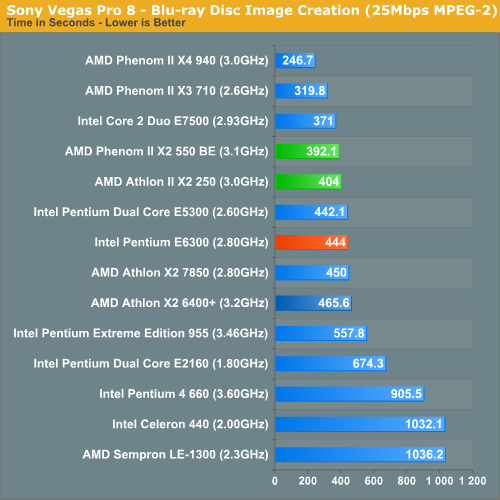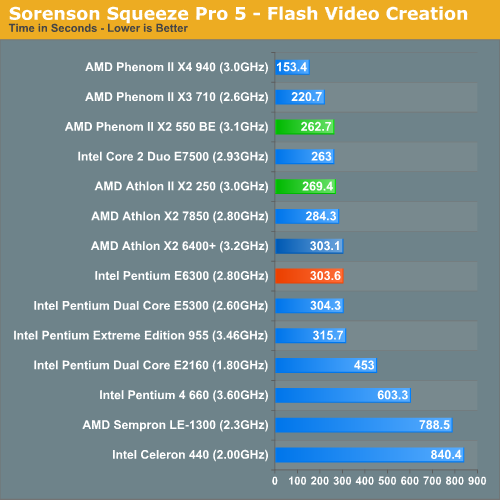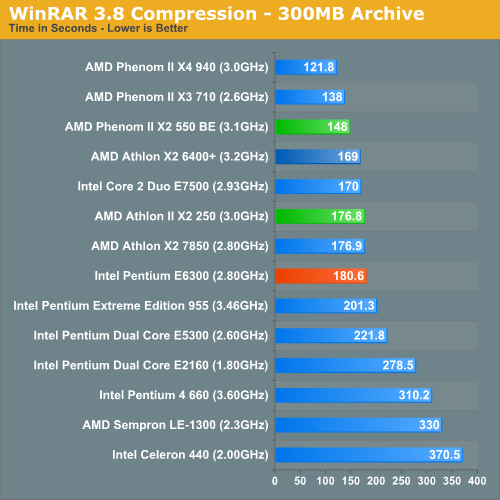The Athlon II X2 & Phenom II X2: 45nm Dual-Core from AMD
by Anand Lal Shimpi on June 2, 2009 12:00 AM EST- Posted in
- CPUs
PAR2 Multithreaded Archive Recovery Performance
Par2 is an application used for reconstructing downloaded archives. It can generate parity data from a given archive and later use it to recover the archive
Chuchusoft took the source code of par2cmdline 0.4 and parallelized it using Intel’s Threading Building Blocks 2.1. The result is a version of par2cmdline that can spawn multiple threads to repair par2 archives. For this test we took a 708MB archive, corrupted nearly 60MB of it, and used the multithreaded par2cmdline to recover it. The scores reported are the repair and recover time in seconds.

Microsoft Excel 2007
Excel can be a very powerful mathematical tool. In this benchmark we're running a Monte Carlo simulation on a very large spreadsheet of stock pricing data.

Sony Vegas Pro 8: Blu-ray Disc Creation
Although technically a test simulating the creation of a Blu-ray disc, the majority of the time in our Sony Vegas Pro benchmark is spend encoding the 25Mbps MPEG-2 video stream and not actually creating the Blu-ray disc itself.

Sorenson Squeeze: FLV Creation
Another video related benchmark, we're using Sorenson Squeeze to convert regular videos into Flash videos for use on websites.

WinRAR - Archive Creation
Our WinRAR test simply takes 300MB of files and compresses them into a single RAR archive using the application's default settings. We're not doing anything exotic here, just looking at the impact of CPU performance on creating an archive:











55 Comments
View All Comments
vajm1234 - Tuesday, June 2, 2009 - link
its really hard to believe ad a lil concern for upcoming c2d processors --- why that 6300 sample didnt overclock? wat was wrong 3.7 i xpct normally but i m amazed as its a 45nm.... not 90 or 65crimson117 - Tuesday, June 2, 2009 - link
I'm getting image not found for this first image on the last page of the review:http://www.anandtech.com/reviews/cpu/amd/athlon2/l...">http://www.anandtech.com/reviews/cpu/amd/athlon2/l...
ShawnD1 - Tuesday, June 2, 2009 - link
I like how you included the overclockability at stock voltage. Since all of my computers use stock heatsinks, overclocking at stock voltage is pretty much all I can do.Gary Key - Tuesday, June 2, 2009 - link
I used the standard heatsink off the Phenom II 940 on the X2 250, 1.4V, and hit 3.825GHz in Win7 64, idle temps around 33C, full load at 54C. I have retail CPUs coming with the new cost reduced heatsink to see what happens but any stock AM2+ heatsink from a Phenom/PhenomII works wonderfully for overclocking these two CPUs.RamarC - Tuesday, June 2, 2009 - link
I know AMD has 'nudged' mobo makers to prevent this, but some still allow it. I'm curious why Anand didn't experiment with it.AnnonymousCoward - Wednesday, June 3, 2009 - link
I figured those extra cores have defects.Anand Lal Shimpi - Tuesday, June 2, 2009 - link
It's more of a timing issue than anything else. I spent a lot of last week working on Lynnfield and there's one more CPU review before this week is up. I am curious about it and will look into it shortly though :)Take care,
Anand
flipmode - Tuesday, June 2, 2009 - link
Hi Anand. Great review, it is much appreciated. The first thing I looked for was a comparison to the Brisbane CPU. To me, a comparison to Brisbane and a comparison to Penryn are the two most interesting.Just thoughts.
ltcommanderdata - Tuesday, June 2, 2009 - link
I'm guessing if Phenom II X2s use harvested cores, they'll eventually be a limited commodity. Still, the Athlon II X2 seems to have a lot of scaling room left so higher clocked Athlon II X2s will probably do just as well.I just flipped through the benchmarks this morning, but since I was one of those commenting on wanting to see the best of dual core Netburst processors like the 965EE for comparison, I wanted to thank you for deciding to include the 955EE.
ltcommanderdata - Tuesday, June 2, 2009 - link
As a follow-up is AMD still making 90nm dual cores or have they converted the fab to 45nm now? I believe the previous fastest dual core was still the 3.2GHz 90nm Athlon 64 X2 6400+. It's too bad it wasn't included here.